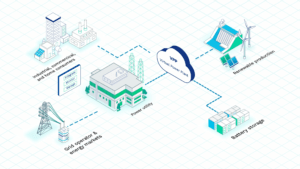
Aleksandr Sepp – Head of Strategic Partnerships
Working at Fusebox as the Head of Strategic Partnerships in Virtual Power Plant (VPP) software sales has given me a unique opportunity to speak with a wide range of power utilities across Europe, from small local operators to some of the largest players in the industry. Over the last four years, I’ve had the chance to understand what challenges they face when it comes to Distributed Energy Resources (DER) and energy flexibility.
When I approach a potential client, usually a power utility or a Balance Responsible Party (someone responsible for managing energy supply and demand), the first step is to understand their specific problems. After years of these conversations, two main challenges that almost every utility struggles with stand out. Let’s dive in.
Problem 1: Getting access to ancillary markets
One of the biggest challenges power utilities face is accessing ancillary markets, where they help stabilize the grid through services like frequency regulation and voltage control. Think of it as high-tech grid maintenance.
Accessing these markets isn’t as simple as offering extra energy. Utilities first need the right systems for providing balancing services. Then comes the prequalification test to prove their technology works. After that, they need to set up real-time data exchange with the Transmission System Operator (TSO), maintain a control center, and sign agreements with the TSO before they can trade in ancillary markets. It’s a complicated process, but necessary for grid stability.
When talking to power utilities, the main challenge they face is how to access these markets with their diverse assets. They typically have three options:
- Stay as-is and miss out on additional revenue.
- Develop their own software and TSO connection.
- Outsource to a specialized company.
More utilities are realizing that staying as-is isn’t an option. As energy flexibility becomes more critical with the rise of renewables, those who adapt first gain a competitive edge by reducing customer churn and making their services more essential.
Some utilities try to build their own software, but this approach is costly and uncertain. For example, it took us seven years and nearly three million euros to reach the software level we have today. Integration with ancillary markets takes time, regardless of budget, due to TSO bureaucracy.
That leaves outsourcing as the most efficient option for quick access to ancillary markets. However, utilities need to be cautious of VPP solutions that lack transparency, as these can create long-term lock-in with little control over the system’s operation.
How Fusebox solves this
Fusebox simplifies access to ancillary markets by automating key processes like real-time data exchange with TSOs. With experience across eight TSOs in Europe, we streamline prequalification, helping utilities quickly participate in mFRR, aFRR, and FCR services.
Our platform integrates seamlessly with existing systems like day-ahead trading, intraday platforms, and SCADA, ensuring compatibility with utilities’ current infrastructure. This allows them to avoid the cost of building in-house solutions. Fusebox also ensures transparency, so utilities maintain full control over their assets while reducing energy imbalances and navigating ancillary markets efficiently.
Problem 2: Multi-platform optimization
The second major challenge utilities face is managing multiple platforms for asset control. You’ve heard the saying, “Too many cooks spoil the broth.” For power utilities, it’s more like, “Too many platforms spoil the grid.” Energy technology has surged ahead, with solar panels and battery storage systems becoming both more efficient and significantly cheaper. In the past decade, the price of solar panels has dropped by 80-90%, and battery storage costs have fallen by up to 85%. While this is great for consumers, it’s creating a headache for power utilities.
Most utilities already use SCADA systems to manage assets, along with trading engines for day-ahead or intraday trading. That setup worked fine when energy flowed predictably from large power plants to consumers. But with the rise of distributed energy resources (DERs), like residential solar and battery systems, energy flows are no longer predictable. Utilities now face the challenge of managing “prosumers,” people who both consume and produce energy. It’s like trying to guess whether your neighbor will bake cookies for themselves or sell them to the whole street.
This unpredictability can lead to costly imbalances, potentially adding up to millions of euros each year.
How Fusebox solves this

Fusebox’s VPP platform helps utilities integrate DERs by automating the balance between energy consumption and production. Our Energy Management System (EMS) provides real-time monitoring, so utilities no longer have to guess what’s happening at each site. By integrating all DERs into a single system, the platform automatically optimizes and dispatches assets based on live market signals. This reduces imbalance costs and helps utilities manage even the most complex portfolios.
Conclusion
In short, power utilities today are grappling with two major challenges: navigating the complex process of accessing ancillary markets and managing multiple platforms that weren’t designed for today’s dynamic energy landscape. But these problems are solvable. With the right tools, like Fusebox’s VPP platform, utilities can simplify their operations, integrate distributed energy resources, and participate in ancillary markets without getting bogged down by technical hurdles.
Ultimately, it’s all about making the grid work smoothly for everyone—no need to guess if your neighbor is baking cookies or selling them to the whole block.

